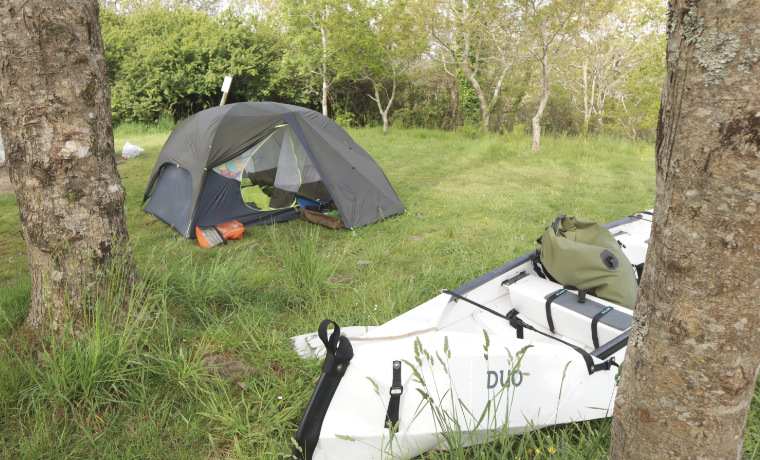Canoe camping, also known as canoe touring, used to be one of those types of adventures that seemed logistically far too complex to get involved in. I always loved the idea of it. But there’s so much extra gear and specialist equipment needed, right?
Well, yes… you’ll need a canoe and buoyancy aid. But you can rent these. And you can even get the outfitter to shuttle your canoes to and from the water at the start and finish of your trip. Plus, if you’ve already got camping gear then you only need to invest in a couple of dry bags to keep your stuff protected, and hey-presto: you can combine all your canoeing and camping experience to create an adventure like no other!
- Canoe camping tips
- What type of canoe is best for canoe touring
- What to pack for a canoe camping trip
- How to choose a campsite for canoe camping
- How to load your canoe for canoe touring
- More canoe camping tips and a few lessons learned
Once I’d completed my first successful canoe camping trip, I realised just how simple it can be, and putting together a good plan is all part of the fun anyway.
Since then, I’ve done a load of canoe camping over the years. And I absolutely love it. Nothing beats the freedom of hitting the water with everything you need for days at a time neatly packed into your floating vessel. There’s something ever-so-Swallows And Amazons about it and no summer is complete for me without at least a couple of canoe camping trips.
In this article you’ll find information on the logistics of canoe camping and how to go about it if you’ve never done it before. Plus I’ll try to share everything I’ve learned from my recent multi day canoe trips.
Canoe camping tips
01Start small
Some of our best canoe camping trips have been very close to home, only paddled a couple of hours to get to camp. You really don’t need to travel or paddle far to have a completely new and unique camping experience. So unless you have lots of experience both canoeing and camping, it’s best to start with an easy paddle that presents very few opportunities for things to go awry.
02Check the weather
And then check it again! But most importantly, take notice of what the wind is forecast to do. The direction and strength of the wind can make or break a canoeing trip. Paddling for hours into a strong headwind, though not impossible, isn’t much. You might want to rethink your route if the wind isn’t playing ball, or at the very least, realign your expectations in terms of enjoyment and distance you hope to cover.
Checking the weather will also give you a heads up if there’s likely to be any drastic changes (storms etc) to plan or account for whilst you’re out on your expedition.
Never be afraid of cancelling or cutting short your trip due to bad weather.
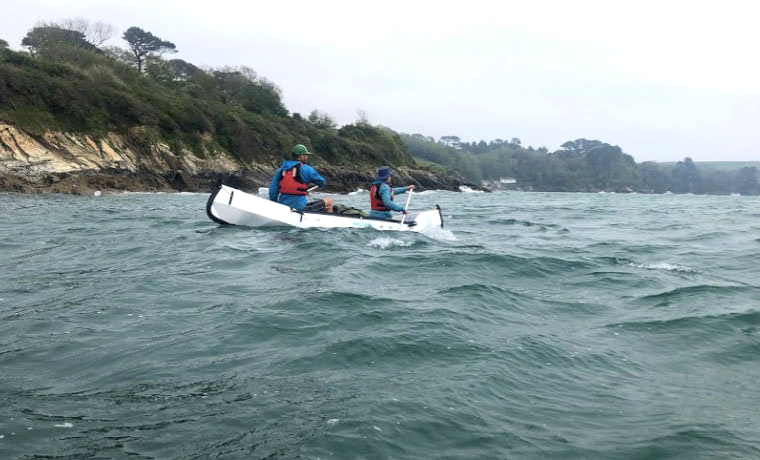
03Understand the water
Generally speaking, paddling on small lakes and slow moving rivers is suitable for relative newcomers to canoeing. However, anything tidal or flowing will pose many variables as to how, when and where you paddle.
To ensure you’re ready to tackle the body of water in which you hope to go canoe camping, it’s a good idea to head out with a guide or a group from whom you can learn the basics. Even if you are experienced and exploring new routes, you’ll need to gather as much information about the flow, currents and tides as possible. Talk to locals, trawl forums and chat to other river users or canoe outfitters before you go.
04Pack light (ish)
One of the best things about canoe camping compared with backpacking is that you don’t need to go super lightweight when it comes to packing. Sure, you don’t want to be hauling along unnecessary stuff. But if you fancy bringing along your extra warm sleeping bag, a small camping chair or even a bottle of wine, then feel free! Just remember that, although the extra weight won’t have too much of an effect on your paddling efficiency, you’ve still got to carry your stuff to and from your boat.
So I tend to pack lightweight and minimally where I can which then leaves some room for a couple of luxuries.
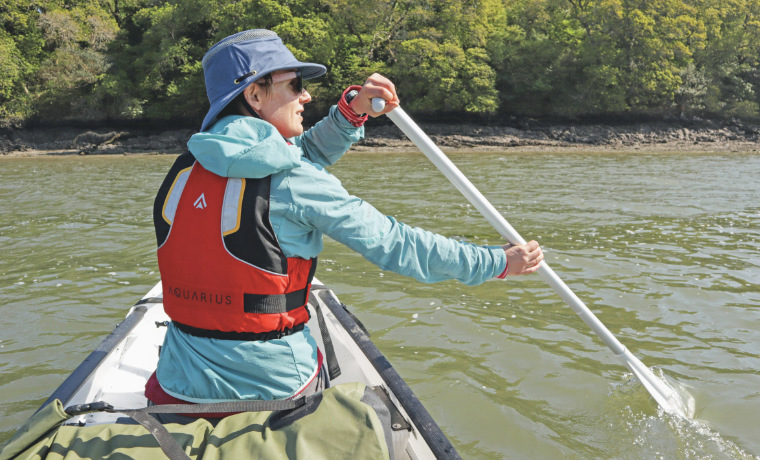
06Have a plan B
As with any kind of adventure, canoe camping trips don’t always go to plan. Your boat might suffer irreparable damage or one of your crew might sustain a wrist injury. The wind might change unexpectedly making it dangerous to continue your mission or you might capsize and lose all your food and gear.
Have a think about all the possible things that could go wrong and then have a back-up plan. Knowing some possible get out points and understanding where the nearest road is in relation to those points is a good place to start. Don’t let these things put you off your trip, just use them to make your plan as bombproof as possible.
If things do go awry then ensure you have the number of the coast guard or equivalent to hand. And don’t hesitate to call them if you need.
06Share your plan
Finally, you should always register your trip with someone responsible who knows exactly what your plan is. This downloadable float plan can be used as a good guide.
What type of canoe is best for canoe touring
As long as you have some space to store your gear, any canoe will do for an overnight canoe camping trip. However, if you plan to travel far and hope to be comfortable for your whole journey then some canoes are much more suitable than others.
Some things to consider when choosing a canoe for touring:
- Length
Longer canoes tend to move more quickly through the water which is a big bonus when travelling far. They also track better, which means that they stay straight when paddling. - Width
Like length, the narrower a canoe is, the faster and straighter it will paddle. However, narrow canoes can also be less stable in the water, which can be a downside if you are relatively new to canoeing. - Weight
Low weight isn’t too crucial, unless you are paddling on your own or having to do lots of portages. In this case, opting for something that doesn’t weigh too much will most certainly make getting on and off the water much easier. - Comfort
If you are paddling for many hours at a time, staying comfortable in your canoe will be more important than you think. If this is top priority then you may need to sacrifice other more appealing canoe characteristics, like width. A wider boat provides more space for storing gear, which in turn allows you to spread out a bit.
- Length
Having done canoe camping in a few different types of canoes over the years, we’ve been loving the space, comfort and convenience of the MyCanoe folding canoe we’ve been using this year. For more information read our full review of the MyCanoe Duo.
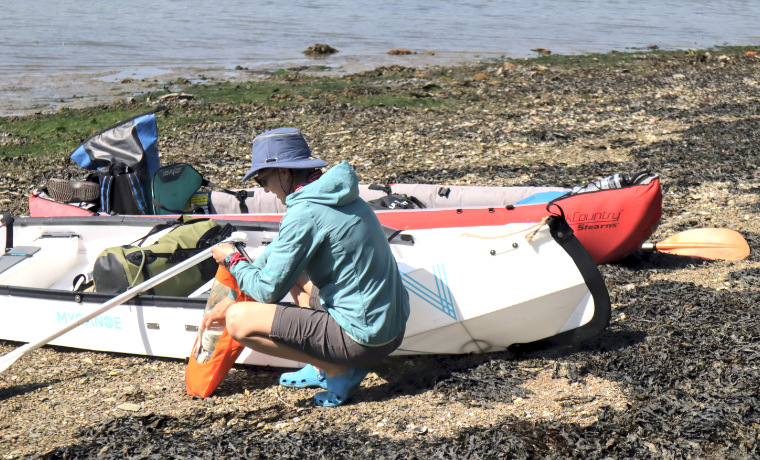
What to pack for a canoe camping trip
There’s no set way to pack for a canoe camping trip, and of course everyone has different things they like to take. The list below is what I like to take and is a good guide for you to build upon to suit you.
Click the ‘x’ to delete items off the list that you know you don’t need. Then click the box next to all the other items once you’ve packed them.
Alternatively, we’ve put together a printable canoe camping checklist PDF to tick and cross with a good old-fashioned pencil! You can also add your own items to this.
Large dry bag:
Ideally, there should be nothing in this dry bag that you need during the day. It will only be opened when you set up camp in the evening.
Sleeping stuff
Spare clothes
Personal items
Medium dry bag
If you have one dry bag that you don’t fully rely on for its waterproof capabilities then use it here. Again, this bag doesn’t really need to be accessed during the day, unless you plan on having a hot drink or soup at lunchtime. If so, then be sure to pack the items you may need at the top of the bag for easy access.
Cooking equipment and food
Safety gear and other items
Small dry bag:
This bag should be easy to access throughout the day whilst you are on the water. It should include things that you will need most often.
Easy access items
Other items
These are items that don’t need to be stored in a dry bag, but they do need to be securely attached to the board or to a dry bag.
Canoe camping checklist PDF
If you want to make life as easy for yourself as possible, print out the below canoe camping PDF. Handily, it has space to write in extras that aren’t already on the list and you can easily share it with your hiking buddies to guide them through what to take bike touring.
Download Canoe Camping Gear ChecklistDry bags for canoe camping
As described above, you will need at least three dry bags. If you have more than three then you’ll have more flexibility on what you pack into each one. But you also need to consider what attachment points are available on your canoe and work around them. There’s no use having 5 small dry bags if you’ve got nothing to attach them to.
Also, there are certain items that I like to store in a small dry bag and then pack into a bigger one,like my sleeping bag and my insulated jacket. At least then, if everything else gets wet in a worst case scenario, you still have something dry and warm to get into later. If you don’t have a small dry bag, use a large zip lock bag, or even two heavy duty plastic bags.
Another thing to consider is whether your dry bags have external attachment points. If your canoe is lacking places to attach gear (shoes, water etc) then see if you can attach them to your dry bags instead.
If there’s space in your canoe, then opting for a dry barrel might appeal to some people. The benefits of this is that all your stuff is in one place making it easier to transport to and from your boat. However, I personally find them a bit cumbersome and restrictive, especially if you have to portage your boat and gear. Dry bag backpacks are the best in this scenario, in my opinion.
Canoe camping meals
Though keeping things relatively lightweight is important, you don’t need to go super lightweight when it comes to food. One pot meals are always a good option as they are easy to cook on a single stove or over a fire. I like to bring lots of fresh veggies and cook up a stew or a pasta dish. Tinned tomatoes or jars of pesto work well too. It’s a good idea to pack fresh food into its own bag within a larger dry bag.
For more ideas check out these one pot camping recipes, my favourite halloumi and pepper camping stew and these campfire desserts.
Some people like to snack throughout the day instead of having a proper lunch. That comes down to personal preference. But for some lunch and snack ideas read our backpacking food article.
If you’re a snacker, then consider packing your snacks into a small, accessible dry bag that’s close to hand. You don’t want to be unnecessarily opening up dry bags whilst on the water so just keep all the items you might want to access as you paddle in the same bag.
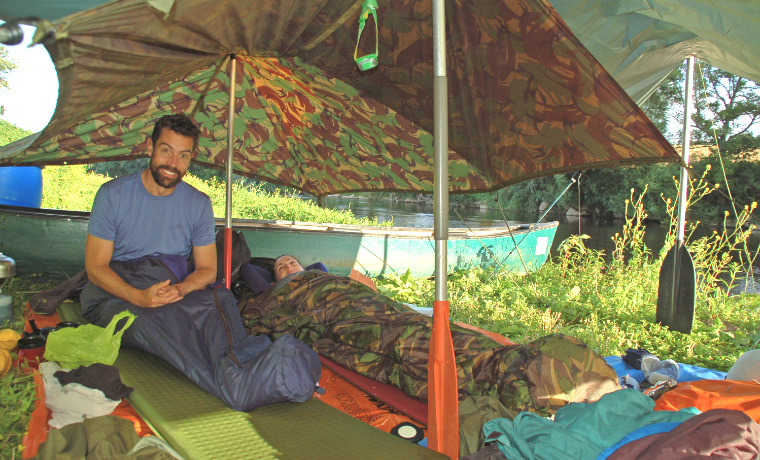
Tent, hammock or bivvy bag when canoe camping
Your choice of camping accommodation largely comes down to personal preference, but also where you are likely to be camping, as well as the weather.
Bivvying is often a good option if you are likely to be sleeping on a beach as it’s more discreet than a tent and also doesn’t rely on finding places to stake a tent down to. Couple it with a tarp in case of bad weather and you’ve got a pretty great shelter. You can use your canoe paddle as a pole for the tarp and even prop up your canoe on its side to form extra shelter at ground level, if needed.
For more information read our tarp camping article and our guide to bivvying.
Hammock camping is a superb choice if you are exploring forested shorelines or riversides. You don’t need to worry about beaches being tidal or finding a flat enough spot to pitch a tent. Plus, if you’re feeling adventurous, you can set up your hammock over the water!
Read our guide to hammock camping to get a better idea whether this might work for you, or not.
Tents offer the greatest level of protection from bad weather and bugs, and are an excellent option if you know there is likely to be flat ground available to set up on. However, unless you have a lightweight backpacking tent, most tents are bulky to pack and are heavy. That said, they can be easily split so that each member of your group carries a part each. And if poles are too long to fit in a dry bag then they can be secured on the outside of a bag or inside your canoe. Just be sure that they are secured very well!
Read our guide to backpacking tents to understand what sort of size and weight tents are available.
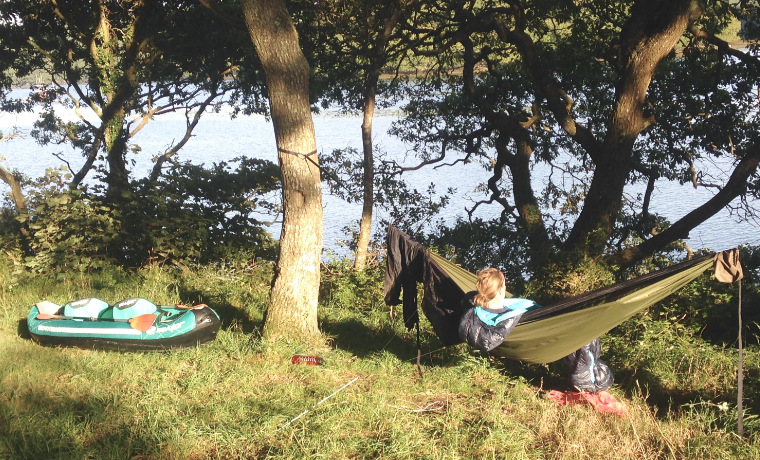
Drinking water for canoe camping
If you know there will be fresh water available that you can filter, then you’ll only need to take a couple of litres with you. I like to take a water bladder that can be attached to the yoke of the canoe and easily sipped from as I paddle.
If collecting water is likely to be an issue then you’ll need to take it all with you. Again, bladders, collapsible flasks or soft containers work well for this as they are easy to store in the canoe and even easier to carry once empty.
If you have a fancy buoyancy aid then it may even have pockets big enough to carry a water bladder or small bottle.
How to load your canoe for canoe camping
You’ve got all your gear packed into dry bags, and you know exactly what’s in every dry bag, right? Now you need to load up your canoe. It’s essential that you do a practice pack and load at home so that you can customise things if you need to. Have some extra bungee cords and carabiners at the ready!
Generally speaking, a canoe should be loaded with the weight balanced more or less equally between the front and back, with a little less weight at the front. All the heavy things should be placed over the centre line of the canoe to prevent it from leaning or tracking to one side.
Once you’re on the water with all your gear packed into your canoe, be sure to assess the trim (how it is positioned in the water) of the canoe before you set off. If there is too much weight at one end then you’ll need to move things around until the load is more evenly distributed.
The more you go canoe camping, the more you’ll figure out what works for you, and what doesn’t.
Depending on the wind, you may need to adjust your packing. Paddling into a headwind can be a bit easier if there’s more weight at the front. So it’s worth playing around with your dry bags if you’re struggling to stay on track into the wind.

How to choose a campsite for canoe camping
Choosing an appropriate place to camp when canoe touring is much like choosing a place to camp when backpacking.
Ideally, your camping spot should be:
- Discreet – not seen by houses or settlements
- Not on private land
- Not in a narrow river valley
- Close to drinking water, if possible
- On flat, dry land
- Sheltered
- Positioned facing a great view!
For more information about wild camping read our article on how to camp at the beach, and also get some ideas from our stealth camping guide!

Other things to consider when canoe camping
The nature of canoe camping means that you will almost always end up camping close to water, which can bring a few challenges with it.
Bugs!
Depending on the location and the time of year, bugs can be a real issue when camping near the water. Getting a fire going, if appropriate, will help fend off bugs, to a degree. But you may also need to bring bug nets, repellent and citronella candles. If so, adjust the above packing list accordingly.
Tides
Is the area you are camping in tidal? If so then you’ll need to be very sure of the high tide line if you are considering camping on a beach. You will also need to know whether the next incoming tide is a spring or neap tide.
Dams
If you are touring on a lake and hoping to camp on its edge then check whether the lake is dammed or not before you head off. I’ve made the mistake of camping on a lake beach only to find out – when I felt water lapping at my feet in the middle of the night – that the lake was dammed! I had no idea. And I certainly didn’t realise that the water level would rise that much in such a short period of time, despite the lack of rain. It’s a mistake you’ll only make once! I had to abandon camp at 4am, pack up and paddle on.
Wildlife
One of the best parts about canoe camping is the ability to get to really wild places where wildlife flourishes. This provides an excellent opportunity to get closer to the natives from the calm and quiet of the water. However, it’s a good idea to do a little bit of research before you go about what you might encounter. Some places are restricted or protected at certain times of the year for breeding etc.
Additionally, those beautifully tranquil beaches that would be ideal for camping on may also be favoured by larger beasties who come down to the water to feed and drink! So check the area for obvious animal trails or tracks before you settle in for the night.
Leave No Trace
As with all types of camping and outdoor activities, it’s imperative that you follow the Leave No Trace Principles when canoe camping. In fact, cruising untouched waters provides the perfect opportunity to do some litter picking as you paddle. So why not take a spare bag along to fill up with any trash you might come across?
For a reminder of the Leave No Trace Principles, take our quiz.

More canoe camping tips and a few lessons learned
Here are a few other small tidbits of information that may be of value to those new to the world of canoe camping:
- A propped up canoe makes an excellent windbreak for cooking behind
- Practise a self-rescue with gear on board
- Don’t underestimate how much harder/easier the wind makes paddling
- Do a test pack so that you know everything fits inside your canoe, including you!
- Prioritise comfort, if you can – it will make your time on the water so much more enjoyable!
Whether it’s a short overnight trip or a multi-day canoe camping epic, may your watery wanderings into the wilderness by boat be fun, safe and full of adventure.
Happy paddling, happy campers!




